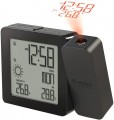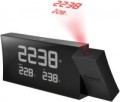Effective range
The maximum distance to the main unit of the weather station where an external sensor can be placed. For wired versions (see "Type of external sensor") this indicator corresponds to the length of the standard cable; for wireless, a guaranteed radio communication range is usually indicated within the visibility limit, provided there is no interference or foreign objects in the signal path. Anyway, it should be taken into account that the maximum installation range is usually less than the claimed range in fact. This is due to the fact that the wire can rarely be laid in a straight line, and the radio signal, in turn, is affected by obstacles and electromagnetic interference. Therefore, it is worth choosing a weather station for this parameter with a certain margin.
Indoor measuring range
The temperature range at which the weather station's internal temperature sensor (see "Measurements") can operate normally. Of course, for normal use, it is need to the temperatures in the room do not go beyond the specified range — otherwise the device will give a warning about the impossibility of measurements in the best case, and at worst it will fail altogether. However, it should be noted here that temperature fluctuations inside residential and office buildings are relatively small, and even in the most inexpensive weather stations, the operating range of the corresponding sensors covers these fluctuations with an impressive margin. Therefore, it makes sense to pay close attention to the measurement temperature in the room only when the device is purchased for non-standard applications — for example, for installation in a greenhouse or in a warehouse with low temperatures.
Outdoor measuring range
The temperature range for which the external temperature sensor of the weather station is designed (see "Measurements"). This parameter must correspond to the temperature differences that this sensor may be exposed to during operation — otherwise, malfunctions and even hardware failures are possible. Of course, it is worth choosing a model according to external temperature, taking into account the climate in which it is planned to be used; at the same time, it is worth taking a certain margin both in the lower and in the upper side. The last is connected not only with the possibility of climatic fluctuations, but also with the fact that outdoor equipment can be heated from direct or reflected sunlight; this, of course, must be avoided in every possible way, but it is not always possible to find an perfect fitting location for the sensor.
More features
— Display of the temperature trend. This "weather forecast" relies on recent temperature measurements. A decline in parameters suggests an impending cold spell, while an increase indicates imminent warming. The function predicts whether temperatures will rise or fall in the very near future.
— Backlight display. The display of the weather station incorporates a backlight feature, enabling information readability in low-light to complete darkness. While this consumes energy, it is particularly relevant for self-powered models. However, since the backlight is typically used for only a few seconds, the associated additional costs are minimal. The backlight may come in various colors and, in some instances, serves decorative purposes.
—
Clock. The weather station includes its own clock, initially displaying the current time. However, the clock's data can be used for additional functions like recording temperature extremes and operating an alarm clock. Clocks can be electronic or analog, typically aligning with the weather station's mechanism type. Some models even offer the option to synchronize time precisely through radio signals.
—
Alarm clock. The weather station features an alarm clock function, emitting a sound signal at a user-set time. Beyond waking up, this signal can serve various purposes, such as event alerts or task reminders. As alarms inherently require a clock (see a
...bove), the available signals vary among models — ranging from a standard sound to multiple options. Advanced models may even permit users to download custom sound files (see "Connecting to a PC").
— Calendar. Availability of a calendar function in the weather station. The simplest option involves at least displaying the current date and day of the week, advanced features may include viewing a calendar table for a month or even a year. The calendar can be used not only by itself, but also for other functions — primarily informing about sunset/sunrise (see above).
— Moon calendar. The presence in the weather station of a calendar that displays the phases of the moon. This information can be used for a variety of purposes, from monitoring tides to finding the best time for gardening or beauty/medical treatments. The moon calendar is usually combined with the usual one (see above).
— FM receiver. The weather station includes an FM-range receiver, enhancing the user experience with access to a variety of stereo music stations. However, it's important to note that FM broadcasting has a limited range, typically within line of sight (a few kilometers). This function may be less useful in remote areas far from cities. Optimal reception requires an external antenna, which can be a traditional telescopic antenna or the wire of an external sensor or headphones.
— Photo frame. The weather station has the capability to function as a digital photo frame, allowing users to view photos on its high-quality color display or run a slideshow for aesthetic appeal. While the display quality contributes to the cost, this feature is primarily aesthetic, as viewing photos is often more convenient on dedicated devices like smartphones or tablets. As a result, this function hasn't gained widespread popularity.
— Projector. The weather station features a built-in projector, enabling the display of various data (weather, time, etc.) on walls, ceilings, or other surfaces, essentially transforming them into impromptu displays. This projection method can be more convenient than viewing information on the main device display in certain situations. However, such models tend to be expensive. The projector typically takes the form of a rotary unit, allowing optimal adjustment of the projected "picture" position.Transmitter power source
This concerns how the transmitter in the external sensor of a weather station is powered, specifically for wireless sensor models. Wired sensors, as mentioned earlier, don't have transmitters; they derive the required energy for operation through a wired connection.
The majority of models use sensors powered by standard-sized, replaceable batteries — either disposable or rechargeable cells. This choice is driven by considerations of battery life and the convenience of swiftly swapping out depleted batteries without removing the entire sensor. While this method incurs additional costs for separate battery purchases — either ongoing expenses for disposables or a relatively higher upfront cost for rechargeables—these drawbacks are generally deemed non-critical. Overall, the advantages of this approach outweigh these concerns for several reasons.
Dimensions
Dimensions of the main unit of the weather station. This option allows you to estimate the space required to install the device. However, most modern models are very compact, it makes sense to pay close attention to the dimensions only when you have to install the device in a very cramped place.
Transmitter dimensions
Dimensions of the wireless unit (see "Type of external sensor") that the weather station is equipped with. Such units are usually small, and finding space for their installation is not a problem; however, in some situations (for example, when placed in a miniature wall niche), accurate dimensions may not be superfluous.

